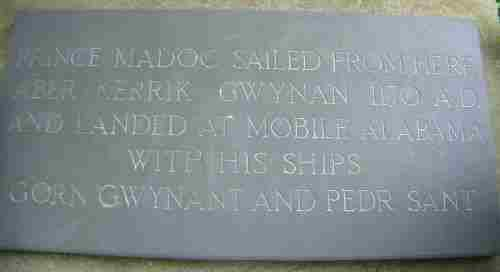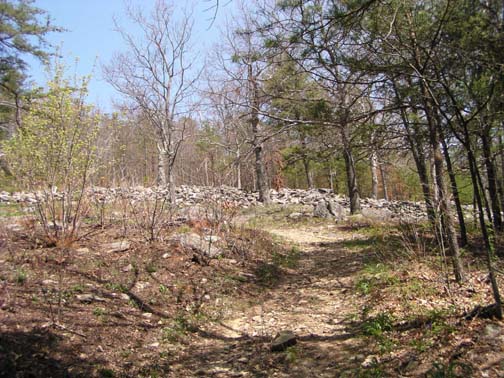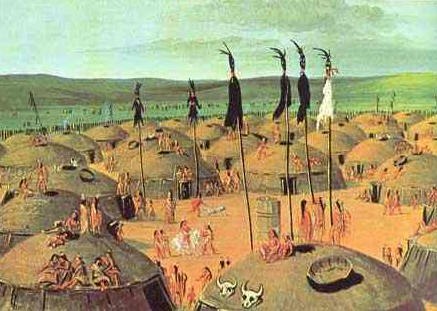http://www.irishcentral.com/roots/history/old-spanish-document-suggests-irish-were-in-america-before-columbus-190817901-237769001.html
According to this research and ancient documentation, an Irish settlement existed in the area of South Carolina and into Georgia prior to the arrival of Columbus and the Spanish explorers.
Previously, I've read up on all of the old legends concerning Prince Madoc, of Wales, who supposed brought a colony of persons and settled in the area of Fort Morgan, Alabama, intermarried with a small group of Native Americans, over time and slowly traveled north, becoming what was known as the "Mandan Indians", into the arrival of British colonies and then eventually becoming extinct, as many native tribes did.
Madoc

 |
| Photo of remains of Fort thought to have been built and occupied by Prince Madoc and his clan. Photo by Jimmie Lee Robbins.
John Sevier, Tennessee’s first governor, in response to a request written to him in 1810 by a researcher into the history of Louisiana, wrote the following.
Copy of letter to Major Amos Stoddard, 2nd Corps, U.S. Army
from John Sevier, Governor of Tennessee.
Knoxville, 9 October, 1810
Sir:
Your letter of Aug.30 ult.,is before me. With respect to the information you have requested, I shall with pleasure give you so far as my own memory will now serve me; and also aided by a memorandum taken on the subject, of a nation of people called the Welsh Indians. In the year 1782 I was on a campaign against some part of the Cherokees; during the route I had discovered trace of very ancient tho’ regular fortifications. Some short time after the expedition I had an occasion to enter into a negotiation with the Cherokee Chiefs for the purpose of exchanging prisoners. Mter the exchange had been settled, I took an opportunity of enquiring of a venerable old chief called Oconostota, who then and had been for nearly sixty years the niling chief of the Cherokee Nation, if he could inform me what people it had been which had left such signs of Fortifications in their Country and in PreColumbian Explorer Sites in the Southeast particular the one on the bank of Highwassee River. The old chief immediately informed me: "It was handed down by the Forefathers that the works had been made by the white people who had formerly inhabited the Country, and at the same time the Cherokees resided low down in the country now called South Carolina; that a war had existed between the two nations for several years. At length it was discovered that the whites were making a number of large Boats which induced the Cherokees to suppose they were about to Descend the Tennessee River. They then assembled their whole band of warriors and took the shortest and most convenient route to the Muscle Shoals in order to intercept them on thek passage down the river. In a few days the Boats hove in sight. A warm combat ensued with various success for several days. At length the whites proposed to the Indians that they would exchange prisoners and cease hostilities, they would leave the Country and never more return, which was acceded to; and after the exchange parted friendly. That the whites then Descended the Tennessee down to the Ohio, thence down to the big river (the Mississippi) then they ascended it up to the Muddy River (the Missouri) and thence up that river for a great distance. That they were then on some of its branches, but, says he, they are no more a white people; they are now all become Indians, and look like the other red people or the Country."
I then asked him if he had ever heard any of his ancestors saying what nation of people these whites belonged to. He answered: "He had heard his Grandfather and Father say they were a people called Welsh; that they had crossed the Great Water and landed first near the mouth of the Alabama River near Mobile and had been drove up to the heads of the waters until they bad arrived at Highwassee River by the Mexican Indians who bad been drove out of their own Country by the Spaniards."
Many years ago I happened in company with a French-man, who had lived with the Cherokees and said he had formerly been high up the Missouri. He informed me he had traded with the Welsh tribe; that they certainly spoke much of the Welsh dialect, and tho’ their customs was savage and wild yet many of them, particularly the females, were very fair and white, and frequently told him that they had sprung from a white nation of people. He also stated that some small scraps of old books remained among them, but in such tattered and destructive order that nothing intelligent remained in the pieces or scraps left. He observed, their settlement was in an obscure quarter on a branch of the Missouri running through a bed of lofty mountains. His name has escaped my memory.
The chief Oconostota informed me: "An old woman in his nation called Peg had some part of an old book given her by an Indian who had lived high up the Missouri, and thought it was one of the Welsh tribe." Before I had an opportunity of seeing it, her house and all the contents burnt. I have seen persons who had seen parts of a very old and disfigured book with this old Indian woman, but neither of them could make any discovery of what language it was printed in (neither of them understood languages, but a small smattering of English).
I have thus, Sir, communicated and detailed the particulars of your request, so far as I have any information on the subject, and wish it were more comprehensive than you will find it written.
Georgia's Ft. Mountain and Prince Madoc of Wales
|
THE STORY OF THE WALL AT FORT MOUNTAIN
Fort Mountain derives its name from an ancient rock wall which protects the highest point of the mountain. The wall, extending 885 feet, is seven feet in height at its tallest point and shows evidence of being much higher when first built. Up to 12 feet wide, with 29 pits scattered at regular intervals along its length, the wall is without peer in southeastern archaeology. Archaeological findings indicate that the ancient fortification long predates the Cherokees who were living there in the 1700s.
The Cherokee's called the wall-builders "moon-eyed people," because they could see better at night than by day. These moon-eyed people were said to have fair skin, blonde hair and blue eyes. Some theorists believe that these moon-eyed people built the wall as a part of sun worship, while others believe it was used in athletic games. Some of the other thoughts pushed from time to time are that Hernando de Soto, who spent two peaceful weeks here in 1540 built it or that the Cherokees created the wall to defend themselves against Creek attackers.
Currently, most scholars believe that the wall originated about 1100A.D. and has a religious purpose. Many early cultures built structures related to astronomical events. In this case the wall runs east to west around a precipice. The effect is that the sun illuminates one side of the wall at sunrise and on the other side at sunset. Native American cultures worshipped the sun and all things in nature. The absence of religious artifacts supports this theory since it was common practice for Native Americans to take ceremonial objects with them when they moved.
The state of Georgia erected a monument at the base of the summit several years ago describing the various legends associated with Fort Mountain. The most important story revolves around the Welsh prince Madoc who is said to have arrived in Mobile Bay around 1170 and moved north from there. The mysterious wall is said to have been built by Welsh Explorers as a fortification against hostile Indians and for ancient ceremonies. Several petroglyphs support the existence of this legend. Following is a paper which could very well explain and clarify the story.
The story of Prince Madoc of Wales is certainly compelling and limited archeological and historical evidence persists, but not with as much fervor, tradition and physical evidence as that of the Vikings.
It is now pretty commonly accepted that Leif Erickson discovered Canada far earlier than Columbus's voyage in 1492.
http://news.nationalgeographic.com/news/2012/10/121019-viking-outpost-second-new-canada-science-sutherland/
Since the theory was brought forward, historians and archealogists have been hard at working looking for proof of viking settlement and exploration....and finding it.

Leif Erickson
So with the Vikings discovering Canda, the Welsh settling in Alabama, warring with the Cherokee and moving up the Tennessee river and eventually becoming the Mandan Indians, and now the possibility that the Irish settled South Carolina and Georgia, it really appears that Columbus was late in his 'discovery' of America. So, where is our Leif Erickson Day? Or our Prince Madoc Day? Or St. Brendan Day?
St. Brendan? It may be that his legendary journey that resulted in the reputed Irish Colony in Carolina.
St. Brendan, Irish monk.
So, while Americans of all 'races' (quoted because there is actually just one..called Human) are finding traces of Native American ancestry through the relatively new science of DNA testing, Native Americans could be finding European ancestry in their DNA that predates the arrival of Columbus. There was apparently no real 'discovery' of America. She has been here and inhabited for a loonnnggg time.






